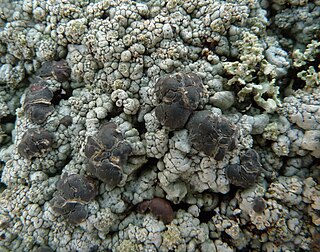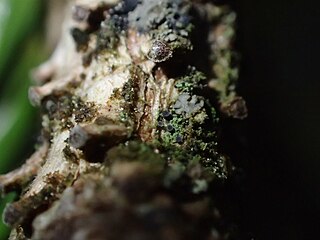
The Lecanoraceae are a family of lichenized fungi in the order Lecanorales. Species of this family have a widespread distribution.

The Stereocaulaceae are a family of lichen-forming fungi in the order Lecanorales. It contains five genera. Species of this family are widely distributed in temperate boreal and austral regions.

The Icmadophilaceae are a family of lichenized fungi in the order Pertusariales. The family was circumscribed in 1993, and contains 8 genera and 27 species.

Trapeliopsis is a genus of lichenized fungi in the family Trapeliaceae. It contains 20 species. The genus was circumscribed in 1980 by Hannes Hertel and Gotthard Schneider, with Trapeliopsis wallrothii designated as the type species.
Rimularia is a genus of lichenized fungi in the family Trapeliaceae. Rimularia was circumscribed by Finnish botanist William Nylander in 1868.
Speerschneidera is a single-species genus of lichen-forming fungi in the family Leprocaulaceae. The genus was circumscribed by Italian botanist Vittore Benedetto Antonio Trevisan de Saint-Léon in 1861, with Speerschneidera euploca as the type species. This lichen was originally described by Edward Tuckerman in 1858 as Physcia euploca. It is a crustose lichen found in the southern United States and Mexico.

Szczawinskia is a genus of leaf-dwelling lichens in the family Pilocarpaceae. The genus contains five species. The genus was circumscribed by Canadian mycologist Alvin Funk in 1984, with Szczawinskia tsugae assigned as the type species.
Malcolmiella is a genus of lichenized fungi in the family Pilocarpaceae.
Redonia is a genus of lichenized fungi in the family Caliciaceae. It contains the single species Redonia chilena, a squamulose lichen. The type specimen was collected in Tarapacá, Chile, where it was found growing on calcareous soil. The genus was circumscribed in 1973 by Carroll William Dodge. The genus name honours Jorge Redón Figueroa, a Chilean lichenologist who collected the type.
Henrica is a genus of crustose lichens in the family Verrucariaceae. It has four species. The genus was circumscribed by Maurice Bouly de Lesdain in 1921, with Henrica ramulosa assigned as the type species. The generic name Henrica honours Italian clergyman and lichenologist Joseph-Marie Henry (1870–1947).

The Lecideaceae are a family of lichens in the order Lecideales.
Konrad Friedrich Ludwig Beckhaus was a German Protestant clergyman and botanist.

Hertelidea is a genus of crustose lichens in the family Stereocaulaceae. Characteristics of the genus include carbon-black ring or outer margin (exciple) around the fruit body disc (apothecium), eight-spored, Micarea-type asci and mostly simple, hyaline ascospores that lack a transparent outer layer. Hertelidea species mostly grow on wood, although less frequently they are found on bark or soil. While the type species, Hertelidea botryosa, has a widespread distribution, most of the other species are found only in Australia.

Schaereria is a genus of lichen-forming fungi. It is the sole genus in the family Schaereriaceae, which itself is the only family in the Schaereriales, an order in the subclass Ostropomycetidae of the class Lecanoromycetes. Most Schaereria species are crustose lichens that live on rocks. Schaereria was first proposed by Gustav Wilhelm Körber in 1855 and was later taken up by other lichenologists despite periods of disuse.
Klaus Kalb is a German lichenologist and an authority on tropical lichens.
Henricus (Harrie) Johannes Maria Sipman is a Dutch lichenologist. He specialises in tropical and subtropical lichens, and has authored or co-authored more than 250 scientific publications. He was the curator of the lichen herbarium at the Berlin Botanical Garden and Botanical Museum from 1983 until his retirement in 2010.

Oxneria is a genus of foliose lichens in the family Teloschistaceae. It has four species. The genus was circumscribed in 2003 by Sergey Kondratyuk and Ingvar Kärnefelt, with Oxneria alfredii assigned as the type species.
Hannes Hertel is a German botanist and taxonomist and was Director of the State Herbarium in Munich, Germany 1992 - 2004. His specialist areas are the fungi and lichens.
Lobaria hertelii is a species of foliose lichen in the family Peltigeraceae. Found in New Guinea, it was formally described as a new species in 2004 by Dutch lichenologist Harrie Sipman.
Schaereria xerophila is a species of saxicolous (rock-dwelling), crustose lichen in the family Schaereriaceae. Found in Australia, it was formally described as a new species in 1989 by lichenologists Gerhard Rambold and Helmut Mayrhofer. The type specimen was found growing on lowland, inland siliceous rock in Queensland, but its range has been expanded to include Tasmania. It is one of five species of Schaereria to occur in Australia. Some diagnostic characteristics of Schaereria xerophila include its crustose, areolate thallus, semi-immersed apothecia, and roughly spherical, non-halonate spores.








